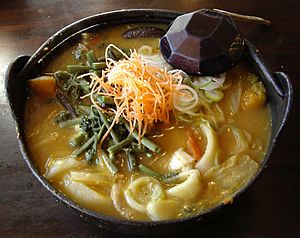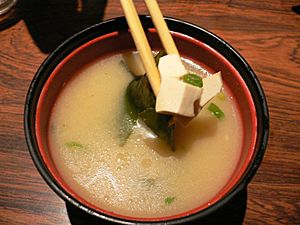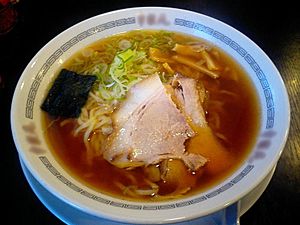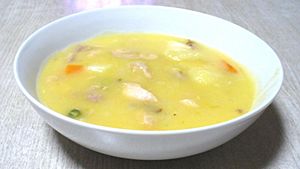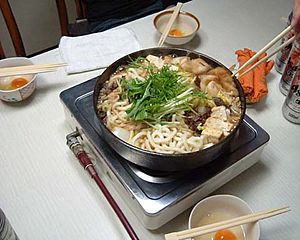List of Japanese soups and stews facts for kids
Japanese food is super popular around the world, and two of its most comforting dishes are soups and stews! In Japan, a typical meal often includes "one soup, three sides." This shows how important soup is in their daily meals. Japanese soups and stews are known for their rich flavors and healthy ingredients. They are perfect for warming up or enjoying a delicious, hearty meal.
Contents
Types of Japanese Soups
Japanese soups are called shirumono. They come in many different styles, from clear broths to thick, hearty bowls. They are often served with rice and other side dishes.
- Butajiru (also called tonjiru) – This is a tasty soup made with pork and lots of vegetables. It gets its rich flavor from miso, a savory paste made from fermented soybeans.
- Dashi – This is a basic but very important soup stock used in almost all Japanese cooking. It's usually made from dried bonito flakes and kelp, giving it a unique savory taste called umami.
- Kasujiru – A warming soup made with sake kasu, which are leftover bits from making sake (Japanese rice wine).
- Kenchin jiru – This is a clear soup packed with vegetables and tofu. It's a healthy and light option.
- Miso soup – One of the most famous Japanese soups! It's made with dashi broth and miso paste, often with tofu, seaweed, and green onions.
- Noppe – A traditional vegetable stew, often served during special occasions or in colder regions.
- Ohaw – A traditional soup from the Ainu people, who are native to Hokkaido, Japan. It often features fish and wild vegetables.
- Suimono – This is a general name for clear, traditional Japanese soups. They are usually light and elegant.
- Ushiojiru – A clear soup made with clams, giving it a fresh, seafood flavor.
- Torijiru – A simple and comforting chicken soup.
- Zenzai – In Okinawa, this refers to a sweet red bean soup served over shaved ice with mochi (rice cakes). It's more of a dessert!
- Zōni – A special soup eaten on New Year's Day in Japan. It always includes mochi and various other ingredients depending on the region.
Delicious Noodle Soups
Noodle soups are a big part of Japanese cuisine, offering a complete meal in one bowl.
- Champon – A noodle dish that comes from Nagasaki, Japan. It's known for its mix of seafood, pork, and vegetables all cooked together in a rich broth.
- Hōtō – A regional dish from Yamanashi Prefecture. It's made by stewing flat udon noodles and vegetables in miso soup.
- Instant noodles – Super popular worldwide! They are quick and easy to prepare.
- Cup Noodle – A famous brand of instant noodles that comes in a convenient cup.
- Okinawa soba – A unique noodle dish from Okinawa. It uses thick wheat noodles, similar to udon, in a pork-based broth.
- Ramen – Perhaps the most famous Japanese noodle soup! It features wheat noodles in a savory broth, topped with various ingredients like sliced pork, seaweed, and eggs.
- Tonkotsu ramen – A very rich and creamy type of ramen, made with a pork bone broth that's been simmered for many hours.
- Udon – Thick, chewy wheat noodles. There are many ways to enjoy udon, like Kitsune udon, which is topped with sweetened deep-fried tofu pockets.
Hearty Japanese Stews
Japanese stews, called nimono, are often slow-cooked to bring out deep flavors from their ingredients.
- Cream stew – A Yōshoku (Western-style Japanese food) dish. It's made with meat and mixed vegetables cooked in a thick, creamy white sauce.
- Gyusuji Nikomi or Motsu Nikomi – Stews made with beef tendons (gyusuji) or offal (motsu), slow-cooked until tender and flavorful.
- Nikujaga – A comforting stew made with meat (usually beef or pork), potatoes, and onions, simmered in a sweet soy sauce broth.
- Zosui – A light and savory rice porridge, often made by adding rice to the leftover broth from a hot pot dish.
Fun Hot Pot Dishes (Nabemono)
Nabemono are Japanese hot pot dishes, where ingredients are cooked at the table in a shared pot. It's a fun and social way to eat!
- Chankonabe – A hearty stew commonly eaten by sumo wrestlers. It's packed with protein and vegetables to help them gain weight.
- Dojō nabe – A hot pot dish made with loach fish, a specialty from Asakusa in Tokyo.
- Fugu chiri – A hot pot made with fugu (pufferfish). This dish must be prepared by specially trained chefs because parts of the fish can be poisonous.
- Harihari-nabe – A unique hot pot featuring minke whale meat and mizuna greens.
- Imoni – A popular hot pot from the Tohoku region, made with beef and potatoes. It's often enjoyed outdoors during autumn festivals.
- Kiritanpo – A hot pot dish from Akita Prefecture, featuring grilled rice sticks (kiritanpo) cooked with chicken and vegetables.
- Motsunabe – A hot pot made with offal (organ meats) and vegetables, popular in Fukuoka.
- Oden – A popular winter hot pot with various ingredients like fish cakes, boiled eggs, and daikon radish, simmered in a light soy-flavored broth.
- Shabu-shabu – Thinly sliced meat and vegetables are quickly swished in a hot broth at the table, then dipped in sauces.
- Sukiyaki – A famous hot pot where thinly sliced beef, vegetables, and tofu are simmered in a sweet and savory soy sauce broth.
Images for kids
-
Sukiyaki is a popular Japanese hot pot dish.
-
Nabemono are hot pot dishes cooked at the table.
-
Ramen is a very popular noodle soup.
-
Zōni is a special soup eaten on New Year's Day.
See also
- Aonori – A type of edible green seaweed used in Japanese soups and other dishes.
- Asian soup
- Japanese noodles
- List of Japanese condiments
- List of Japanese dishes
- List of Japanese desserts and sweets
- List of Japanese ingredients
- List of ramen dishes
- List of soups
- List of stews
- Tsukemen


